A brief note on the existence of connections and covariant derivatives on modules.
DOI:
https://doi.org/10.4067/10.4067/S0716-09172017000200225Keywords:
Connection, Covariant derivative, Projective moduleAbstract
In this note we make a review of the concepts of connection and covariant derivative on modules, in a purely algebraic context. Throughout the text, we consider algebras over an algebraically closed field of characteristic 0 and module will always mean left module. First, we concentrate our attention on a k-algebra A which is commutative, and use the Kähler differentials module, Ω¹A/k, to define connection (see Subsection 2.1). In this context, it is verified that the existence of connections implies the existence of covariant derivatives (cf. Prop. 2.3), and that every projective module admits a connection (cf. Prop. 2.5). Next (in Section 3), we focus our attention in the discussion of some counterexamples comparing these two notions. In fact, it is known that these two notions are equivalent when we consider regular k-algebras of finite type (see [18], Prop. 4.2). As well as, that there exists a connection on M if, and only if, the Atiyah-Kodaira-Spencer class of M, c(M), is zero (see [17] , Prop. 4.3). Finally, we take into account the case where A is (not necessarily commutative) and it is used the bimodule, Ω¹, of noncommutative differentials introduces by Connes [9], [10] in place of Kähler differentials to define a connection. In this case, it is proven that a module admits such connection if, and only if, it is a projective module (see [25], Theorem 5.2).
References
ATIYAH, M. F. (1969) Introduction to Commutative Algebra. Reading, MA: Addison-Wesley.
BORN, M. (1926) On quantum mechanics II. EN: Zs. Phys. 35. [s.l.: s.n.], 557-615.
BRUMATTI, P. (1995) The Module of Derivations of a Stanley-Reisner Ring. EN: Proc. Amer. Math. Soc., 23(5). [s.l.: s.n.], 1309-1318.
CARMO, M. P. DO. (1992) Riemannian Geometry. Boston: Birkhäuser.
CARTAN, E. (1924) Les espaces à connexion conforme. EN: Ann. Soc. Polon. Math., 2. [s.l.: s.n.], 171-221.
CARTAN, E. (1924) Sur les variétés à connexion projective. EN: Bull. Soc. Math. France, 52. [s.l.: s.n.], 205-241.
CARTAN, E. (1956) Homological Algebra. [s.l.]: Princeton University Press.
Christoffel, E. B. (1869) Uber die Transformation der homogenen Differentialausdrücke zweiten Grades. EN: Journal für die reine u. angew. Math. (Crelle) 70. [s.l.: s.n.], 46-70.
CONNES, A. (1985) Non-commutative differential geometry. EN: Inst. Hautes Etudes Sci. Publ. Math. 62. [s.l.: s.n.], 257-360.
CONNES, A. (1994) Non-commutative geometry. [s.l.]: Academic Press.
CUNTZ, J. (1995) Algebra Extensions and Nonsingularity. EN: J. Amer. Math. Soc. 8 (2). [s.l.: s.n.], 251-89.
DIRAC, P. (1926) The fundamental equations of quantum mechanics. EN: Proc. Roy. Soc. A 109. [s.l.: s.n.], 642-653.
EISENBUD, D. (1995) Commutative Algebra with a View Toward Algebraic Geometry. EN: Graduate Texts in Math. 150. New York: Springer.
EHRESMANN, C. (1943) Sur les espaces fibrés associés à une variété différentiable. EN: C. R. Acad. Sc. t. 216. [s.l.: s.n.], 628-630.
EHRESMANN, C. (1950) Les connexions infinitésimales dans un espace fibré diffrentiable. EN: Colloque de Toplogie. Bruxelles: CBRM, 29-55.
ELLIS, J. (20??) A Historical Profile of the Higgs Boson. [s.l.: s.n.]. arXiv:1201.6045.
ERIKSEN, E. (1995) Connections and monodromy on modules. EN: Technical Report. [s.l.]: University of Oslo.
ERIKSEN, E (2000) Graded D-modules over Monomial Curves, Ph. D. thesis. [s.l.]: University of Oslo.
GELFAND, I. M. (1943) On the imbedding of normed rings into the ring of operators on a Hilbert space. EN: Math. Sbornik 12(2). [s.l.: s.n.], 197-217.
GOMES, R. (2009) Conexoes e Curvatura: Uma abordagem algébrica, Dissertacao de mestrado, DM-UFPE. [s.l.: s.n.].
HARTSHORNE, R. (1977) Algebraic Geometry. EN: Graduate Texts in Math. 52. New York: Springer.
HENRIQUE, M. L. (2001) Derivacoes e Campos de Vetores, Dissertacao de mestrado, DM-UFPE. [s.l.: s.n.].
FERREIRA, N. (2010) Conexoes e Transporte Paralelo: Abordagem Computacional, Disserta¸ cao de mestrado, DM-UFPE. [s.l.: s.n.].
KOSZUL, J. L. (1950) Homologie et cohomologie des algebres de Lie. EN: Bull. Soc. Math. France, 78. [s.l.: s.n.], 65-127.
KRÄHMER, U. (2009) Dirac Operators, Lecture 1: Projective Modules and Connections. EN: IPM Tehran 19. [s.l.: s.n.].
LEVI-CIVITA, T. (1901) Méthodes de calcul diffrential absolu et leurs applications. EN: Math. Ann. B. 54. , pp. 125-201, (1901).
NESTRUEV, J. (2003) Smooth manifolds and observables. EN: Graduate Texts in Math. 220. New York: Springer-Verlag.
ROJAS, J. (2013) O Funcional de Yang-Mills, Disserta¸ cao de mestrado, DMUFPE. [s.l.: s.n.].
SILVA, R. B. DA. (2013) Existência de conexoes versus módulos projetivos, Disserta¸ cao de mestrado, DM-UFPB. [s.l.: s.n.].
SWAN, R. G. (1962) Vector Bundles and Projective Modules. EN: Trans. Amer. Math. Soc. 105 (2). [s.l.: s.n.], 264-277.
Published
How to Cite
Issue
Section
-
Attribution — You must give appropriate credit, provide a link to the license, and indicate if changes were made. You may do so in any reasonable manner, but not in any way that suggests the licensor endorses you or your use.
- No additional restrictions — You may not apply legal terms or technological measures that legally restrict others from doing anything the license permits.











